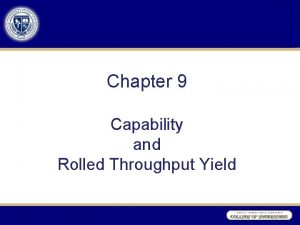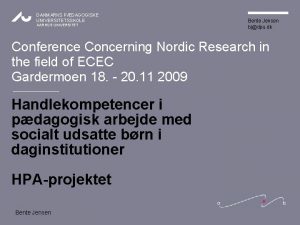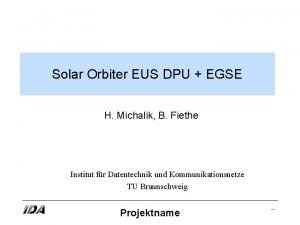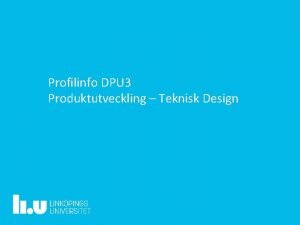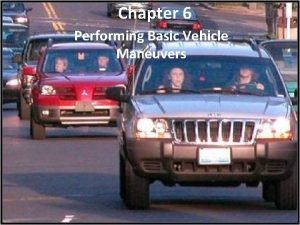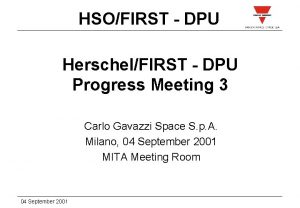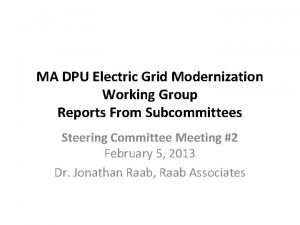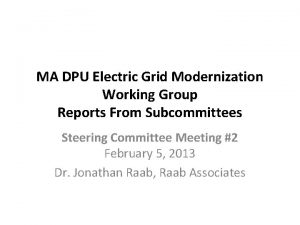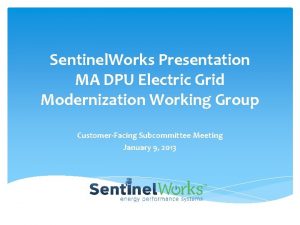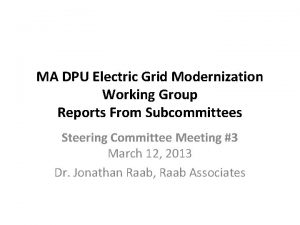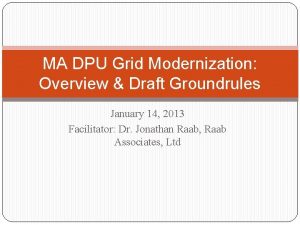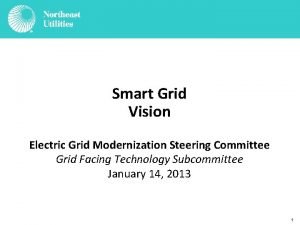Grid Modernization CostEffectiveness Framework DPU Grid Modernization Steering











- Slides: 11

Grid Modernization Cost-Effectiveness Framework DPU Grid Modernization Steering Committee Meeting #1 December 17, 2012 Tim Woolf www. synapse-energy. com | © 2011 Synapse Energy Economics Inc. All rights reserved.

Overview of This Discussion • Tim Woolf, Synapse Energy Economics: – Overview of cost-effectiveness issues. • Bernie Neenan, Electric Power Research Institute: – EPRI experience with cost-effectiveness at national level. • Melissa Chan, Navigant Consulting: – DOE assessment of Smart Grid grants. • Phil Hanser & Sanem Sergici, Brattle Group: – Experience analyzing cost-effectiveness in other states. • Discussion among Steering Committee members. – Presentation of perspectives and discussion of next steps. Tim Woolf – Grid Modernization Cost Effectiveness Framework Slide 2

Recent Study of Cost-Effectiveness for Demand Response • Prepared for: US DOE & FERC. – Follow-up to National Action Plan for Demand Response. • Authors: Synapse Energy Economics and the Regulatory Assistance Project. • Working Group: Included demand response experts from around the country. • Release date: January 2013. • Much of the findings are directly relevant to grid modernization cost-effectiveness framework. • Key issues are summarized below, slides 4 -9. Tim Woolf – Grid Modernization Cost Effectiveness Framework Slide 3

Energy Efficiency Cost Effectiveness Framework • Five standard tests are widely used as the framework for presenting energy efficiency costs and benefits. • • • Participant test; Rate Impact Measure (RIM) test; Program Administrator Cost (PAC) test; Total Resource Cost (TRC) test; and Societal Cost test. • In Massachusetts, and many other states, the Total Resource Cost test is the primary test used to screen energy efficiency programs. • These same tests are relevant for analyzing demand response cost-effectiveness. Tim Woolf – Grid Modernization Cost Effectiveness Framework Slide 4

Energy Efficiency Cost Effectiveness Framework Participant RIM PAC TRC Societal Energy Efficiency Program Costs: Program Administrator Costs --- Yes Measure Cost: Rebate to Participant --- Yes Yes Yes --- --Yes ----- Yes ----participant ----Yes Yes Yes --utility ----Yes Yes --participant ----Yes Yes societal Measure Cost: Participant Contribution Lost Revenues to the Utility Energy Efficiency Program Benefits: Customer Bill Savings Measure Cost: Rebate to Participant Avoided Generation Costs Avoided Transmission & Distribution Costs Avoided Cost of Environmental Compliance Environmental Externalities Other Program Benefits, Tim Woolf – Grid Modernization Cost Effectiveness Framework Slide 5

Demand Response Program Costs Cost Participant RIM PAC TRC Societal Program Administrator Expenses -- Yes Yes Program Administrator Capital Costs -- Yes Yes Financial Incentive to Participant -- Yes -- -- DR Measure Cost: PA Contribution -- Yes Yes DR Measure Cost: Participant Contribution Yes -- -- Yes Participant Transaction Costs Yes -- -- Yes Participant Value of Lost Service Yes -- -- Yes Increased Energy Consumption -- Yes Yes Lost Revenues to the Utility -- Yes -- -- -- Environmental Compliance Costs -- Yes Yes Environmental Externalities -- -- Yes Tim Woolf – Grid Modernization Cost Effectiveness Framework Slide 6

Demand Response Program Benefits Benefit Avoided Capacity Costs Avoided Energy Costs Avoided Transmission & Distribution Costs Avoided Ancillary Service Costs Revenues from Wholesale DR Programs Market Price Suppression Effects Avoided Environmental Compliance Costs Avoided Environmental Externalities Participant Bill Savings Financial Incentive to Participant Tax Credits Other Benefits (e. g. , market competitiveness, reduced price volatility, improved reliability) Participant RIM PAC TRC Societal ----Yes Yes depends Yes Yes Yes Yes ----depends Yes Yes ---Yes depends Yes Yes --Yes ---depends Tim Woolf – Grid Modernization Cost Effectiveness Framework Slide 7

Key Findings of the Demand Response Study • Demand response programs introduce some new costs, e. g. , value of lost service to customer. • A significant portion of the benefits of demand response programs is due to the avoided capacity costs. • Estimating avoided capacity costs is very difficult. • Demand response programs are often justified on the basis of improved reliability. – However, it is very difficult to quantify and monetize this benefit in order to include it in the framework. • Demand response programs offer other benefits that are difficult to quantify and monetize (e. g. , more efficient use of generation and transmission assets). Tim Woolf – Grid Modernization Cost Effectiveness Framework Slide 8

Example Results from a California Electric Utility: 2012 -2014, Aggregated Results for 7 programs Results are based on the TRC test Tim Woolf – Grid Modernization Cost Effectiveness Framework Slide 9

Cost-Effectiveness Questions to Address • There are several questions to be addressed. We will return to them throughout this working group process: – – – Which test / perspective to use? Which costs to include? Which benefits to include? What methodologies to use to quantify costs and benefits? Should hard-to-quantify costs and benefits be included? • For example, reliability benefits. • If so, how should they be included? – – What discount rate should be used? What time period should be included? How should risk be accounted for? Others that may arise. Tim Woolf – Grid Modernization Cost Effectiveness Framework Slide 10

Contact Information Tim Woolf Vice President Synapse Energy Economics 617 -453 -7031 twoolf@synapse-energy. com www. synapse. energy. com Tim Woolf – Grid Modernization Cost Effectiveness Framework Slide 11
 How to calculate rolled throughput yield
How to calculate rolled throughput yield Bente jensen dpu
Bente jensen dpu Dpu
Dpu Dpu master
Dpu master Pin grid array and land grid array
Pin grid array and land grid array Conceptual framework theoretical framework
Conceptual framework theoretical framework Dispositional framework vs regulatory framework
Dispositional framework vs regulatory framework Dispositional framework vs regulatory framework
Dispositional framework vs regulatory framework Theoretical framework sample
Theoretical framework sample Conceptual framework vs theoretical framework
Conceptual framework vs theoretical framework Theoretical framework vs conceptual framework
Theoretical framework vs conceptual framework Steering straight backward
Steering straight backward
